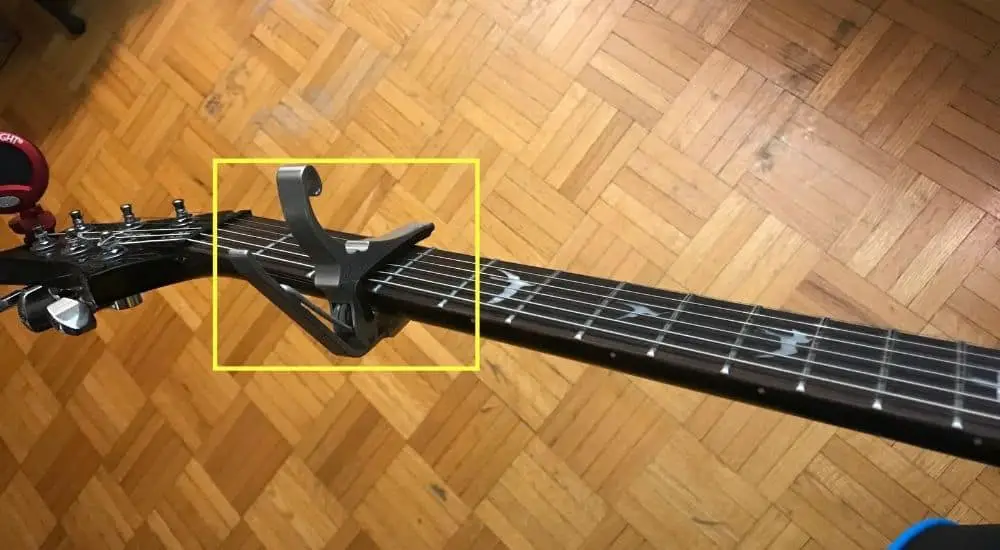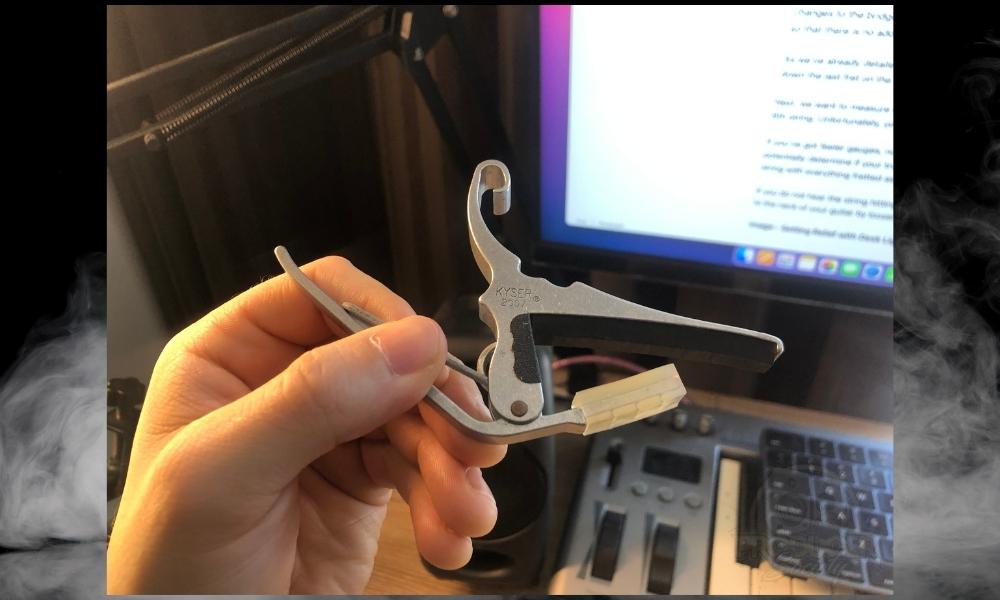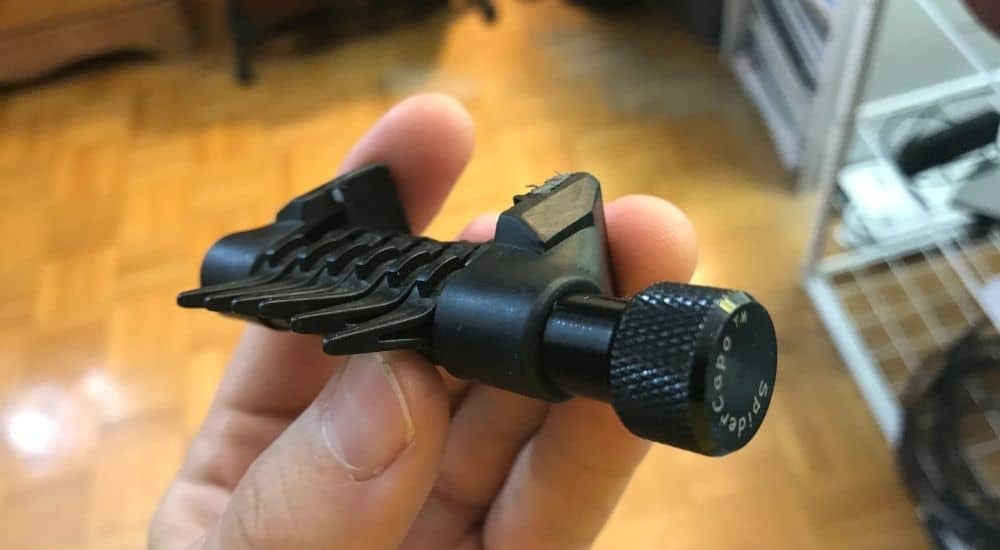A capo is that little device you mostly see guitarists using as a clamp on the neck of their fretboard, but very rarely do you see a bassist use a capo. The capo’s purpose is to change the key signature of the instrument while staying in the same position on the neck. It acts as a moveable nut or fret.
The nut is found at the top of the neck near the tuning pegs and determines the open tuning of the guitar. By moving the capo, you move the open position of the guitar to a different key. But why do you never see capos on bass guitars?
Capos can be used on bass guitars the same way guitars use them. While often not needed, they can still work just as well on a bass guitar as a guitar. A capo can help you write in different keys or match a vocalist better by instantly transposing to a new key signature.
Not all capos are created equal, however. Capos come in different sizes because guitar necks are all different sizes. Each will fit differently because of the material they’re made of, along with the way they’re made. When searching for a bass capo, you will have to find one that is long and sturdy enough to cover all the strings on a bass neck because they’re generally a lot thicker than what you would see on a standard electric or acoustic guitar.
Why Would A Bassist Use A Capo?
As I’ve argued elsewhere on the site, the guitar and the bass guitar are very similar. A bassist would use a capo for the exact same reason a guitarist would: to shift to a new key signature without having to change positioning. A capo can help transpose the key of a song by clamping down onto the strings and neck while simultaneously acting as the nut of the guitar.
It allows the artist to transpose a song immediately without having to relearn the song or teach a new chord progression to another musician.
A simple way of explaining it is that a capo changes the open position on the instrument. So for example, if you place the capo at the 3rd fret, open position is now at the 3rd fret.
This means if you play the open strings, you’ll actually be playing the 3rd fret of each string. You can see what that looks like in the image shown here, although, it’s on the guitar rather than the bass.

A bassist can also use a capo to pull off more advanced techniques like arpeggios and sweep picking, in addition to chord voicings that normally wouldn’t be possible.
The bar technique that we can do easily on guitar is difficult on the bass but may be needed in some situations, so using a capo would help a bassist to pull it off and branch out more with their playing.
One way of jamming with a guitarist who’s using a capo is to simply ask or figure out the key that they’re playing.
At one point in time, I probably would’ve been confused as to how a person would play with another musician who’s using a capo, however, simply knowing the key is all you need to know (obviously knowing the chords helps a lot too). Check out my guide here on figuring out the key.
Why Bassists Can Also Use Capos?

1) Because Bass Guitars Are a Fretted Instrument
If the instrument has frets and those frets lay flat, it can use a capo. As we’ve already discussed, the capo only moves the starting position of the nut, making any fret played with the capo automatically in a higher key.
Capos can only make your tuning sound higher, so placing the capo on any fret will instantly transpose the song into a higher key.
Tuning the strings up by one semitone creates the same effect as using the capo on the 1st fret. If you wanted to tune down a semitone, and then use a capo on the 1st fret to come back to standard tuning, you could do that as well.
You would do this instead of changing basses for different keys if you are playing more than one song and using different tunings, however, I’m not aware of anybody doing this kind of thing on a regular basis, but it’s certainly possible if you wanted too.
The capo can be clamped on a fretted instrument to effectively shorten the strings of that instrument. When you shorten the strings on any instrument, the pitch goes higher. This is why, for instance, the guitar and violin sound very different.
A shorter scale means a higher pitch, and a longer scale means a lower pitch. That’s why a bass guitar’s neck is generally much longer than a guitar’s.

2) They Act as a Third Hand
Capos have their benefits when transposing things to a different key, but what about recognizing how easy it is to play a bass line in an open position, and how easily a capo would facilitate higher open tunings by moving it up on the fretboard?
Certain arpeggios can be implemented easier with a capo too, which is one reason why you might want to use one.
As a bassist, it’s essential to hold down the foundation of the song but keep a melody that is recognizable and memorable. A capo would allow a bassist to do this in different keys with minimal effort by allowing a bar to be placed anywhere on the fretboard.
3) They’re Useful for Tapping Legato Runs in a Different Key
Tapping is a technique that guitarists mainly use, but bassists can also use this in their playing. Using a capo on bass can very well do the same thing.
It’s easier to do arpeggios, legato runs, or sweep-picking when you have a capo on because the fingerings aren’t as far apart from each other.
Moving the capo to a higher fret can make these advanced techniques more accessible and be incorporated into many styles of playing.
No matter if you are playing fast runs or slow melodies, you can enhance the music with the versatility of using a capo.
4) Great for Altered Tunings

Using a spider capo is one way of getting to altered tunings. In case you don’t know, a spider capo is a capo that allows you to fret particular strings rather than every single one of them as a regular capo does. It does this by having six rungs on the capo that are all individually adjustable.
In the image you can see above, the capo clearly has six different adjustable rungs on it that can be used for all kinds of altered tunings. It’s honestly pretty amazing what can be accomplished with a spider capo like this.
Some of the most popular acoustic guitarists use spider capos including people like Andy McKee and Antoine Dufour, just to name two.
5) Capos Can Help With Songwriting
I have to admit that I’m not one for using a capo, however, there was a time when I would use a spider capo to learn songs from the two artists I just mentioned.
Capos and spider capos are cool because they allow you to do write songs that normally wouldn’t be possible with a regularly tuned and played guitar or bass.
For example, you could use a spider capo to tune the note of the bass to the notes of a Cminadd9 chord and maybe you could make something really cool with it. The point that I’m getting at is that the capo is a tool for you to use creatively, and there’s no reason why you can’t also use it for the bass.
6) Capos Can Help With Playing Chords
Because the bass and guitar are fundamentally similar in structure, the way you can play normally open chords in a different position can also be applied to the bass (you can use the same gear for them as well which I’ve argued before). To do this, you would use open chords or moveable chords with a capo.
Playing chords on bass is powerful. It’s not used a whole lot, but it can have a significant impact when done. A lot of bands use bass chords in certain parts of their song to add fullness or wholeness to the track. A capo would make it easier to play many different chords on the bass.
The Difference Between Using a Capo on a Bass Versus a Guitar
The only difference in using a capo on the guitar or bass is the capo itself. A bass capo is longer and a little sturdier than a guitar capo. This is because it needs to hold down the very thick strings that a bass guitar has. Bass capos are also harder to find.
Why You Never See Bassists Using Capos
There are a few reasons why you never see bassists using capos. The main reason is that bassists typically don’t use chords in their playing, and a capo is primarily for shifting open-string chords up to different key signatures, allowing beginner players to play easy chords in different keys.
As we’ve just explained, that doesn’t mean bass guitarists can’t use a capo nor should they. The point that I’m getting at here is that it’s just not as common for bassists to play chords as it is on the guitar, so there just isn’t as much of a need for a capo.
It seems like the most common application of a capo is for beginners to take the open-string chords they learn in 1st position and then apply them all over the neck. In other words, capos allow you to apply a handful of chords that would otherwise be impossible to play elsewhere to different parts of the neck.
This is one reason why some guitar teachers advise against using capos; because some beginner players rely on them too much.
Important Things to Note About Bass Guitars and Capos
1) The Fit of the Capo Matters
You want it to be tight and snug but not damaging to your neck. The hinge will always point toward the ceiling, and the cushioned part lays snuggly over the strings.
You will be able to get a nice clear sound when you play a note on any of the strings. If the intonation sounds off, just readjust until you can hear all the open strings clearly.
2) Make Sure To Check The Tuning Before and After
The capo adds pressure to the strings, so they may go out of tune once the capo is on. The best practice is to always check your tuning before and after setting the capo up on your bass. You can also check that each string resonates properly as you tune and readjust as needed.
3) Pay Attention to the Score or Tablature for Capo Notation
If you are learning a new song from online chord charts or tablature, most arrangements will cite a capo position automatically. This is usually found on arrangements for guitars but will also be cited if the bassist uses one in the arrangement.


 Written By :
Written By :
